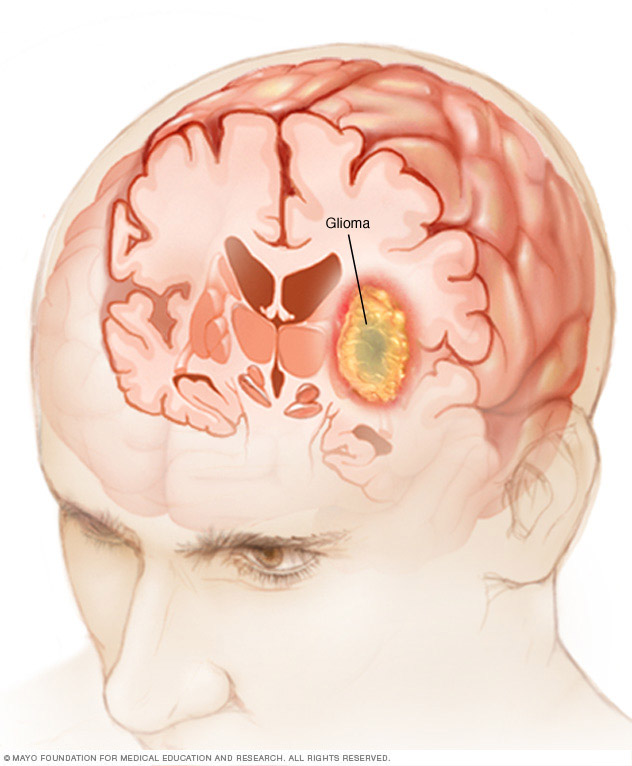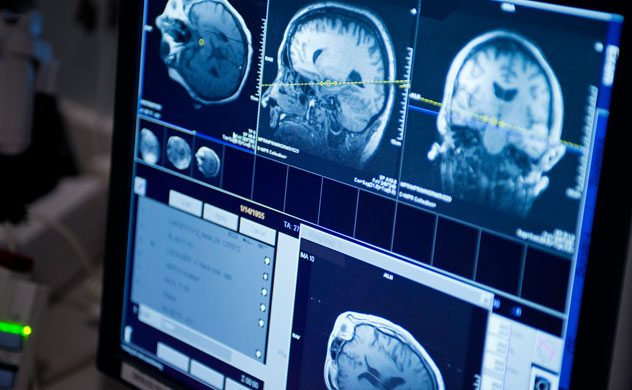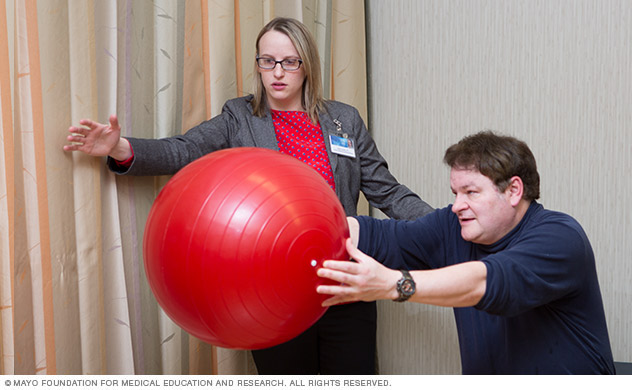Overview
Glioma is a growth of cells that starts in the brain or spinal cord. The cells in a glioma look similar to healthy brain cells called glial cells. Glial cells surround nerve cells and help them function.
As a glioma grows it forms a mass of cells called a tumor. The tumor can grow to press on brain or spinal cord tissue and cause symptoms. Symptoms depend on which part of the brain or spinal cord is affected.
There are many types of glioma. Some grow slowly and aren't considered to be cancers. Others are considered cancerous. Another word for cancerous is malignant. Malignant gliomas grow quickly and can invade healthy brain tissue. Some types of glioma happen mostly in adults. Others happen mostly in kids.
The type of glioma you have helps your health care team understand how serious your condition is and what treatments might work best. In general, glioma treatment options include surgery, radiation therapy, chemotherapy and others.

Symptoms
Glioma symptoms depend on the location of the glioma. Symptoms also may depend on the type of glioma, its size and how quickly it's growing.
Common signs and symptoms of gliomas include:
- Headache, particularly one that hurts the most in the morning.
- Nausea and vomiting.
- Confusion or a decline in brain function, such as problems with thinking and understanding information.
- Memory loss.
- Personality changes or irritability.
- Vision problems, such as blurred vision, double vision or loss of peripheral vision.
- Speech difficulties.
- Seizures, especially in someone who hasn't had seizures before.
When to see a doctor
Make an appointment with your health care provider if you have any signs and symptoms that worry you.
Causes
Doctors aren't sure what causes glioma. It starts when cells in the brain or spinal cord develop changes in their DNA. A cell's DNA contains the instructions that tell a cell what to do.
The DNA changes tell the cells to make more cells quickly. The cells continue living when healthy cells would die. This causes too many cells that don't work right. The cells form a mass called a tumor.
The tumor can grow to press on nearby nerves and parts of the brain or spinal cord. This leads to glioma symptoms and can cause complications.
Some gliomas develop more changes in their DNA that cause them to become brain cancers. The changes tell the cells to invade and destroy healthy brain tissue.
In glioma, the tumor cells look similar to healthy brain cells called glial cells. The glial cells surround and support nerve cells in the brain and spinal cord.
Risk factors
Things that can increase the risk of glioma include:
- Getting older. Gliomas are most common in adults between ages 45 and 65 years old. But glioma can happen at any age. Certain types of gliomas are more common in children and young adults.
- Being exposed to radiation. People who have been exposed to a type of radiation called ionizing radiation have an increased risk of glioma. One example of ionizing radiation is radiation therapy used to treat cancer.
- Having a family history of glioma. Glioma can run in families, but this is very rare. More research is needed to understand whether parents can pass a risk of glioma to their children.
Researchers haven't found anything you can do to prevent glioma.
Diagnosis
Tests and procedures used to diagnose glioma include:
- An exam to test your nerves and brain function. A neurological exam involves checking your vision, hearing, balance, coordination, strength and reflexes. If there's difficulty with a certain task, it might be a clue that there could be a brain tumor.
-
Tests to make pictures of the brain. Imaging tests create pictures of your brain to look for signs of a brain tumor. MRI is the imaging test used most often. Sometimes you have an injection of dye in a vein before your MRI. This helps create better pictures.
Other imaging tests may include CT and positron emission tomography, which is also called a PET scan.
-
A procedure to get a sample of tissue for testing. Sometimes a procedure called a biopsy is needed to remove some of the tissue for testing before treatment begins. It's used when surgery isn't an option for removing the brain tumor. If you will have surgery to remove your brain tumor, you might not need a biopsy before your surgery.
To get the tissue sample, a needle might be used. The needle is guided by imaging tests. This procedure is called stereotactic needle biopsy. During the procedure, a small hole is made in the skull. A thin needle is then inserted through the hole. Tissue is removed using the needle and sent to a lab for testing.
-
Tests on tumor cells. A sample of the brain tumor may be sent to a lab for testing. The sample can come from a biopsy procedure. Or the sample can be taken during surgery to remove the glioma.
The sample is sent to a lab where it's tested by doctors who specialize in analyzing blood and body tissue. These doctors are called pathologists.
Tests in the lab can determine if you have a glioma and what type you have. Other tests might show how quickly the glioma cells are growing. Advanced tests look at what DNA changes are present in the glioma cells. The test results help your health care team confirm your diagnosis and create a treatment plan.

Treatment
Glioma treatment usually begins with surgery. But surgery isn't always an option. For example, if the glioma grows into important parts of the brain, it might be too risky to remove all of the glioma. Other treatments, such as radiation therapy and chemotherapy, might be recommended as the first treatment.
Which treatments are best for you will depend on your particular situation. Your health care team considers the type of glioma, its size and where it's located in the brain. Your treatment plan also depends on your health and your preferences.
Treatments to control symptoms
If your glioma is causing symptoms, you might need medicine to make you more comfortable. Which medications you need depends on your situation. Options might include:
- Medicine to control seizures.
- Steroid medicines to reduce brain swelling.
- Medicine to improves alertness if you have severe fatigue.
- Medicine to help with thinking and memory problems.
Surgery
Glioma treatment usually starts with an operation to remove the glioma. Surgery might be the only treatment needed if all of the glioma is removed.
Sometimes the glioma can't be removed completely. The surgeon may remove as much of the glioma as is possible. This procedure is sometimes called a subtotal resection. It might be needed if the glioma can't easily be separated from the healthy brain tissue. It can also happen if the glioma is in a sensitive part of the brain. Even removing a portion of the tumor may help reduce your symptoms.
Surgery to remove a glioma carries risks. These include infection and bleeding. Other risks may depend on the part of your brain in which your tumor is located. For instance, surgery on a tumor near nerves that connect to your eyes may carry a risk of vision loss.
Radiation therapy
Radiation uses beams of powerful energy to kill tumor cells. The energy can come from X-rays, protons or other sources.
For glioma treatment, radiation therapy is often used after surgery. The radiation kills any glioma cells that might remain after surgery. Radiation is often combined with chemotherapy.
Radiation therapy might be the first glioma treatment if surgery isn't an option.
During radiation therapy, you lie on a table while a machine aims energy beams at specific points on your head. The beams are carefully programmed to deliver precise amounts of radiation to the glioma. A common schedule for radiation therapy is having treatments five days a week for a few weeks.
Side effects of radiation therapy depend on the type and dose of radiation you receive. Common side effects that happen during or soon after radiation include fatigue, scalp irritation and hair loss.
Chemotherapy
Chemotherapy uses drugs to kill tumor cells. Chemotherapy medicines are most often taken in pill form or injected into a vein. In certain situations, the chemotherapy can be applied directly to the glioma cells.
Chemotherapy is usually used in combination with radiation therapy to treat gliomas.
Side effects of chemotherapy depend on the type and dose of medicines you receive. Common side effects include nausea and vomiting, hair loss, fever and feeling very tired. Some side effects may be managed with medication.
Tumor treating fields therapy
Tumor treating fields therapy is a treatment that uses electrical energy to hurt the glioma cells. The treatment makes it hard for the cells to make new glioma cells.
Tumor treating fields therapy is used to treat an aggressive type of glioma called glioblastoma. This treatment is often done at the same time as chemotherapy.
During this treatment, sticky pads are attached to the scalp. You might need to shave your head so the pads can stick. Wires connect the pads to a portable device. The device generates an electrical field that hurts the glioma cells.
Side effects of tumor treating fields therapy include skin irritation where the pads are applied to the scalp.
Targeted therapy
Targeted therapy treatments focus on specific chemicals present within cancer cells. By blocking these chemicals, targeted therapy treatments can cause cancer cells to die.
Your glioma cells may be tested to see if targeted therapy might help you. For slow-growing gliomas, targeted therapy is sometimes used after surgery if the glioma can't be removed completely. For other gliomas, targeted therapy might be an option if other treatments haven't worked.
Side effects depend on the medicine used and the dose given.
Rehabilitation after treatment
Glioma and glioma treatment can hurt parts of the brain that help you move your body and control your thinking. After treatment you might need help to regain your ability to move, speak, see and think clearly. Treatments that might help include:
- Physical therapy, which can help you regain lost motor skills or muscle strength.
- Occupational therapy, which can help you get back to your daily activities, including work, after a brain tumor or other illness.
- Speech therapy, which can help if you have difficulty speaking.
- Tutoring for school-age children, which can help kids cope with changes in memory and thinking after a brain tumor.

Alternative medicine
Little research has been done on complementary and alternative glioma treatments. No alternative treatments have been proved to cure gliomas. However, complementary treatments may help you cope with your glioma and its treatment. Complementary treatments also are called integrative treatments. They can be used at the same time as traditional treatments, such as surgery, radiation therapy and chemotherapy.
Ask your health care team if you're interested in trying complementary treatments such as:
- Acupuncture.
- Hypnosis.
- Meditation.
- Music therapy.
- Relaxation exercises.
Coping and support
A glioma diagnosis can be overwhelming and frightening. It can make you feel like you have little control over your health. But you can take steps to cope with the shock and grief that may come after your diagnosis. Consider trying to:
- Learn enough about gliomas to make decisions about your care. Ask your health care team about your specific type of brain tumor, including your treatment options and, if you like, your prognosis. As you learn more about brain tumors, you may become more confident in making treatment decisions.
- Keep friends and family close. Keeping your close relationships strong will help you deal with your brain tumor. Friends and family can provide the practical support you'll need, such as helping take care of your home if you're in the hospital. And they can serve as emotional support when you feel overwhelmed by cancer.
- Find someone to talk with. Find a good listener who is willing to listen to you talk about your hopes and fears. This may be a friend or family member. The concern and understanding of a counselor, medical social worker, clergy member or cancer support group also may be helpful. Ask your health care team about support groups in your area. Or connect with others online through groups, such as the National Brain Tumor Society and others.
Preparing for an appointment
See your usual health care provider if you have any signs or symptoms that worry you. If you're diagnosed with a glioma, you may be referred to specialists, such as:
- Doctors who specialize in brain disorders, who are called neurologists.
- Doctors who treat cancer with medicine, who are called medical oncologists.
- Doctors who use radiation to treat cancer, who are called radiation oncologists.
- Doctors who specialize in nervous system cancers, who are called neuro-oncologists.
- Surgeons who operate on the brain and nervous system, who are called neurosurgeons.
- Rehabilitation specialists.
Brain tumor treatment can be complex. Few hospitals are used to caring for a lot of people with brain tumors. If you don't feel comfortable with the care at your local facility, consider seeking a second opinion at a more experienced cancer center. Ask your health care provider for a referral.
It's a good idea to be prepared for your appointment. Here's some information to help you get ready.
What you can do
- Be aware of any pre-appointment restrictions. At the time you make the appointment, be sure to ask if there's anything you need to do in advance, such as restrict your diet.
- Write down any symptoms you're experiencing, including any that may seem unrelated to the reason for which you scheduled the appointment.
- Write down key personal information, including any major stresses or recent life changes.
- Make a list of all medications, vitamins or supplements that you're taking.
- Consider taking a family member or friend along. Sometimes it can be difficult to remember all the information provided during an appointment. Someone who accompanies you may remember something that you missed or forgot. This person can be your advocate and help you understand the information you receive from your health care team.
- Write down questions to ask your health care provider. A written list of questions and concerns is helpful when you're feeling overwhelmed. There's a lot of information to process and consider when you're dealing with a serious illness. It's easy to forget the questions you wanted to ask.
Your time with your health care provider is limited, so preparing a list of questions can help you make the most of your time together. List your questions from most important to least important in case time runs out. For a brain tumor such as glioma, some basic questions to ask include:
- What type of brain tumor do I have?
- Where is my brain tumor located?
- How large is my glioma?
- How aggressive is my brain tumor?
- Is my glioma cancerous?
- Will I need additional tests?
- What are my treatment options?
- Can any treatments cure my glioma?
- What are the benefits and risks of each treatment?
- Is there one treatment you feel is best for me?
- Is there a clinical trial available to treat my type of glioma? Is it appropriate for me?
- How will treatment affect my daily activities, such as walking, talking and speaking?
- Should I see a specialist? What will that cost, and will my insurance cover it?
- Are there brochures or other printed material that I can take with me? What websites do you recommend?
- How often should I have checkups?
Note the three questions that are most important to you so you can be sure to get those answered if the time is limited. In addition to the questions that you've prepared to ask, don't hesitate to ask other questions that occur to you.
What to expect from your doctor
Your health care provider is likely to ask you a number of questions. Being ready to answer them may allow time later to cover other points you want to address. Your provider may ask:
- When did you first begin experiencing symptoms?
- Have your symptoms been continuous or occasional?
- How severe are your symptoms?
- What, if anything, seems to improve your symptoms?
- What, if anything, appears to worsen your symptoms?
© 1998-2025 Mayo Foundation for Medical Education and Research (MFMER). All rights reserved. Terms of Use


